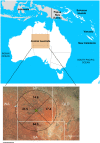Clinical associations of Human T-Lymphotropic Virus type 1 infection in an indigenous Australian population
- PMID: 24454973
- PMCID: PMC3894183
- DOI: 10.1371/journal.pntd.0002643
Clinical associations of Human T-Lymphotropic Virus type 1 infection in an indigenous Australian population
Abstract
Introduction: In resource-poor areas, infectious diseases may be important causes of morbidity among individuals infected with the Human T-Lymphotropic Virus type 1 (HTLV-1). We report the clinical associations of HTLV-1 infection among socially disadvantaged Indigenous adults in central Australia.
Methodology and principal findings: HTLV-1 serological results for Indigenous adults admitted 1(st) January 2000 to 31(st) December 2010 were obtained from the Alice Springs Hospital pathology database. Infections, comorbid conditions and HTLV-1 related diseases were identified using ICD-10 AM discharge morbidity codes. Relevant pathology and imaging results were reviewed. Disease associations, admission rates and risk factors for death were compared according to HTLV-1 serostatus. HTLV-1 western blots were positive for 531 (33.3%) of 1595 Indigenous adults tested. Clinical associations of HTLV-1 infection included bronchiectasis (adjusted Risk Ratio, 1.35; 95% CI, 1.14-1.60), blood stream infections (BSI) with enteric organisms (aRR, 1.36; 95% CI, 1.05-1.77) and admission with strongyloidiasis (aRR 1.38; 95% CI, 1.16-1.64). After adjusting for covariates, HTLV-1 infection remained associated with increased numbers of BSI episodes (adjusted negative binomial regression, coefficient, 0.21; 95% CI, 0.02-0.41) and increased admission numbers with strongyloidiasis (coefficient, 0.563; 95% CI, 0.17-0.95) and respiratory conditions including asthma (coefficient, 0.99; 95% CI, 0.27-1.7), lower respiratory tract infections (coefficient, 0.19; 95% CI, 0.04-0.34) and bronchiectasis (coefficient, 0.60; 95% CI, 0.02-1.18). Two patients were admitted with adult T-cell Leukemia/Lymphoma, four with probable HTLV-1 associated myelopathy and another with infective dermatitis. Independent predictors of mortality included BSI with enteric organisms (aRR 1.78; 95% CI, 1.15-2.74) and bronchiectasis (aRR 2.07; 95% CI, 1.45-2.98).
Conclusion: HTLV-1 infection contributes to morbidity among socially disadvantaged Indigenous adults in central Australia. This is largely due to an increased risk of other infections and respiratory disease. The spectrum of HTLV-1 related diseases may vary according to the social circumstances of the affected population.
Conflict of interest statement
The authors have declared that no competing interests exist.
Figures

References
-
- Verdonck K, Gonzalez E, Van Dooren S, Vandamme A, Vanham G, et al. (2007) Human T-lymphotropic virus 1: recent knowledge about an ancient infection. Lancet Infect Dis 7: 266–281. - PubMed
-
- Gessain A, Cassar O (2012) Epidemiological aspects and world distribution of HTLV-1 infection. Front Microbiol 3: 388 doi: 10.3389/fmicb.2012.00388 - DOI - PMC - PubMed
-
- Shimoyama M (1991) Diagnostic criteria and classification of clinical subtypes of adult T-cell leukaemia/lymphoma. A report from the lymphoma study group. Br J Haematol 79: 428–437. - PubMed
Publication types
MeSH terms
LinkOut - more resources
Full Text Sources
Other Literature Sources

